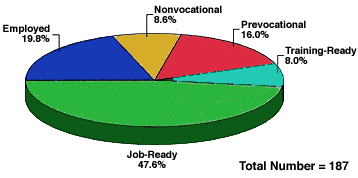Guidance in finding a job is a critical need for patients enrolled in methadone treatment programs for opiate addiction. Holding down a job is a step toward financial security, contributes to self-esteem and a healthier, happier lifestyle, and helps patients stay in treatment and drug free.
However, individuals in methadone treatment face serious obstacles to employment. These barriers include poor motivation that is often sparked by repeated failures in job-seeking efforts. Other common obstacles are lack of training or social support, appropriate tools or equipment, transportation, child care, health care, a driver's license, or clothing.
Many instruments exist for measuring treatment patients' skills, interests, and job abilities, but few assessment tools are available for determining whether patients are ready for vocational rehabilitation.
 Vocational Readiness of Methadone Patients Tested with the Screener
Vocational Readiness of Methadone Patients Tested with the ScreenerEmployed: Currently Works
Job-Ready: Wants a job and has a degree, a certificate, or a high school degree (GED) with at least 2 years work experience
Training-Ready: Wants school or training and has at least a GED
Prevocational: Does not want training or a job and does not have a GED
Nonvocational: Has an illness or disability that precludes vocational activity
That's why NIDA grantees are testing a prototype Vocational Readiness Screener designed to quickly and reliably assess methadone treatment patients' employability and evaluate their vocational barriers and needs. While the testing was conducted in methadone programs, researchers believe many of the job-screening concepts could be used to assist patients in treatment for other forms of substance abuse.
The screener-a questionnaire that is completed by treatment patients in about 15 minutes-is a low-cost, rapid evaluation procedure suitable for routine use by vocational counselors in drug treatment programs, say its authors. It is easy to administer and interpret, says Dr. Michael L. Dennis, formerly of the Research Triangle Institute (RTI) in Research Triangle Park, North Carolina, who is principal investigator of the employability study.
"The Vocational Readiness Screener is a practical instrument to triage vocational services," says Georgia T. Karuntzos, an RTI researcher developing the screener. During triage, patients are first categorized by needs so counselors avoid wasting vocational services on those not currently prepared to receive them. Next, counselors allocate essential services to patients based on their individual needs, job readiness, or work status. The screener has been tested with two groups of methadone treatment patients. The questions, screening process, and interpretation and implementation procedures are being refined by the RTI researchers to improve the screener's validity and reliability.
The screener asks for 96 responses to questions in 5 areas of vocational functioning:
- job status;
- level of motivation to get a job;
- level of social support from spouse, family, friends, or treatment counselors;
- ancillary needs such as transportation to work, medical care, uniforms or work equipment, or a driver's license; and
- barriers to work such as continued illicit drug use, a criminal record or criminal activities, health problems, or racial or gender discrimination.
The screener was most recently tested with 187 methadone treatment patients who volunteered to take part in a NIDA-funded Training and Employment Program (TEP) that was being implemented in treatment centers. TEP seeks cost-effective ways to train and find jobs for methadone patients. TEP patients who participated in the test of the screener had been in treatment for 3 or more months.
"Nearly half (47.6 percent) of the 187 methadone treatment patients who participated in the program gave answers showing that they have the appropriate skills and interests to get a job, but they often lack the necessary level of support or motivation, or they may have needs and barriers that must be addressed before they can get a job," says Dr. Dennis. "Our screener provides a practical way to quickly determine each client's job-related needs."
Researchers look at how patients' vocational status-either nonvocational, prevocational, training-ready, job-ready, or employed-is related to five employability dimensions that are measured by job needs or barriers and levels of support or motivation (see figure above). For example, a patient classified job-ready but lacking transportation to work would receive help in finding transportation; another deemed prevocational but lacking motivation would be counseled and encouraged to seek out and enroll in an appropriate training program. "Determining vocational status, in conjunction with other dimensions of our screening framework, provides a comprehensive profile of employability," explains Ms. Karuntzos.
The screening process can easily be used by treatment providers as a starting point to place patients in training or job rehabilitation efforts appropriate to their specific needs.
"Using this screener, we find that gender, race or ethnicity, and age are important predictors of the job-finding needs of clients," says Ms. Karuntzos.
For example, females are more likely than males to want help with child care while in treatment, other research with methadone patients shows. Other measures of job readiness, such as specific needs and barriers to employment, are identified by using checklists in the screener.
Overzealous attempts to push unready people into jobs can backfire, Dr. Dennis warns, provoking "learned helplessness" when patients feel increasingly powerless in job-seeking efforts after repeated rejections.
"Nearly half of these clients are job-ready, but you need to identify and address the barriers they face to getting a job," he says. "If you push people with these very real barriers into unrealistic job-search struggles, it only increases frustration and undermines what motivation they may have."
Sources:
- Dennis, M.L.; Karuntzos, G.T.; McDougal, G.L.; French, M.T.; and Hubbard, R.L. Developing training and employment programs to meet the needs of methadone treatment clients. Evaluation and Program Planning 16:73-86, 1993.
- French, M.T.; Bradley, C.J.; Calingaert, B.; Dennis, M.L.; and Karuntzos, G.T. Cost analysis of training and employment services in methadone treatment. Evaluation and Program Planning 17:107-120, 1994.